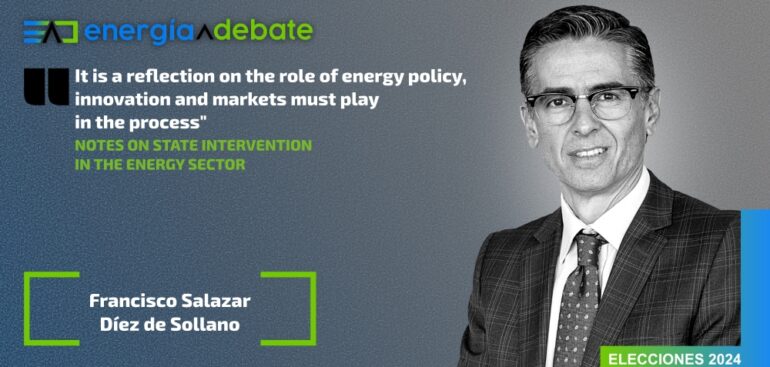By Francisco X. Salazar Diez de Sollano *
There is a variety of ways the State intervenes in the economy and markets. It can do this through fiscal, monetary, industrial, trade and competition policy, among the most relevant. At the same time, it can combine different elements of previous policy and concentrate them in sector policy, as is the case of energy policy.
Public policy such as those mentioned above is based on and scoped in the law framework that, as it is detailed and issued through administrative bodies, becomes regulation. With respect to the latter, it must be added that, unlike the major public policy guidelines that change in every administration, regulation has to be stable and predictable, especially regarding that it is applied to investments that require large capital amounts and typically return in a long term (as in the energy sector). For this reason politics-independent regulators have to be in charge of regulation.
Additionally, other way State can intervene is through companies of its own. This occurs especially when there are legal restrictions on private participation or in the provision of certain public services. Likewise, the ownership of these companies is increasingly mixed and their governance tends to emulate private companies’, seeking to ensure their profitability without compromising their public policy objectives (which should be clear and explicit).
In an economic point of view, State intervention through the above mechanisms is justified when there are market failures such as the absence or restriction to conditions for competition, the presence of externalities, or information asymmetry. A second condition to justify the State intervention is that benefits it provides are greater than the costs it implies. This same criterion is applied to the intervention degree, since too much intervention could be harmful, as the case of over-regulation. Now, although not justified in economic terms, State intervention in markets for purely political reasons is not unusual.
A good example for application of above principles occurred during the energy reform carried out approximately ten years ago in Mexico. On the basis of such principles, we sought to identify the markets in which, due to their nature and structure, competition was more convenient than the legal monopoly until then established in the Constitution. Thus, electricity and hydrocarbon sectors were opened to private participation.
In the case of electric sector, the State maintained exclusivity in planning (because it is a public policy matter), in the system operation (through an organization independent of the CFE though) and in public power transmission and distribution service provision. In this latter case, State exclusivity was maintained considering that such an infrastructure tends to present natural-monopoly conditions and that its privatization would have been controversial (political reasoning). However, private participation was allowed in financing, installation, maintenance, management, operation and expansion through contracts with the State, a scheme not taken advantage of despite the scarcity of public resources.
In addition –and to avoid cross subsidies, unduly discriminatory access to the grid and CFE’s market power exercise– vertical separation of generation, transmission, distribution and supply activities was established under its responsibility, and the horizontal separation of generation as well.
As of hydrocarbon sector, the precept related to the ownership of the Nation over such subsoil resources was reaffirmed, but exploration and extraction by private companies under contracts was permitted (a scheme not taken advantage of by current administration, even though Pemex’s production is at its lowest level in 45 years). In downstream activities, private companies’ right to participate in markets was acknowledged, something that in fact has been restricted by this administration to competition detriment (and, therefore, to the benefit of consumers).
In addition to the independent operator of the electricity sector and the operator created for the integrated natural gas system, both designed to prevent conflicts of interest and guarantee access to the gas pipeline networks and electricity grid, the reform sought to guarantee the autonomy of regulators: CRE, CNH and in a certain way ASEA. Unfortunately, the principle of political independence has not been safeguarded since their integration process, and those regulators have frequently operated against economic competition by illegally limiting private participation.
With respect to state companies, the objective was to make them efficient under a clear mandate of value creation. However, for political and control reasons, the Board of Directors’ configuration was not modified in depth, so conflicts of interest derived from the participation of non-independent government representatives preserved. This problem was aggravated because of the administration change. The new administration sought for a wider political control and disregarding the previous objectives ended up deteriorating financially these companies (in case of Pemex, to the point of bankruptcy).
Beyond details, it is important to note that the overall scheme of state intervention and private participation designed at energy reform 10 years ago is not unique to Mexico. On the contrary, it is a worldwide rule. In Latin America such a scheme prevails, even in countries having or having had left-wing governments, where adjustments tend to be more nuanced, despite the fact that political speech may seem more extremist. An illustrative case is Peru’s Pedro Castillo’s government, of which the focus was not on restricting private participation, but on maximizing additional benefits it could generate for rural communities, such as social support programs and rural electrification projects.
Furthermore, the current debate on state intervention in the energy sector has evolved to focus not so much on private participation, but on a transition to cleaner and more sustainable energy sources. In an economic point of view, discussion is about environmental externalities and how to internalize them. It is a reflection on the role energy policy, innovation and markets must play in this process. Here, the cost-benefit analysis of state intervention is crucial again. This is the approach adopted – although in a different way – by governments such as Boric’s or Petro’s, who in any case see it as essential for the private sector to provide the investments to accelerate a fair energy transition.
“It is a reflection on the role energy policy, innovation and markets must play in this process.”
The exceptions to the model proposed by the energy reform, where the State plays a directing role but is not the only actor, are becoming fewer and fewer and show a resounding failure. Cases such as Venezuela and Bolivia, where hydrocarbon production has sharply fallen (and not precisely due to a decarbonization strategy), illustrate this point. If these exceptions persist despite evidence that ideology by its own does not solve problems, it is because they have become corruptions hotbeds or political control tool. Additional examples include recent changes in El Salvador, designed to allow the government to completely control the sector.
Given the imminent change of government, the question of the role the State should play in this area gains importance once again. Will the new administration choose to accelerate the pace to failed models of exception, or will it get back to the common sense that predominates globally? Will it insist on spoiling state companies to finally bankrupt them, or will it want to focus them on those activities where they can compete and strengthen accordingly? Will it continue to limit potential private investments, or stimulate them with ambitious transition goals? Will it continue using institutions as positions for their close, even if they are incompetent, or will it opt for professional institutions where capacity prevails? Hope future decisions lean towards these second options…

*/ Francisco Salazar es ingeniero químico por la Universidad Autónoma de San Luis Potosí y cuenta con una Maestría en Economía con especialidad en Finanzas Públicas, así como un Diplomado en Economía de Mercados Globales, por la London School of Economics & Political Science (LSE). También tiene un Diplomado en Derecho Parlamentario por la Universidad Iberoamericana.
Tiene amplia experiencia en el ámbito regulador especialmente en el sector energético. Fue comisionado presidente de la Comisión Reguladora de Energía en dos periodos, época en que participó como uno de los arquitectos en la elaboración de las reformas energéticas y del marco regulatorio mexicano.
En este mismo ámbito a nivel internacional también ha tenido un papel destacable. Ha sido coordinador de la Conferencia Internacional de Reguladores (ICER) y miembro del Consejo Mexicano de Asuntos Internacionales (Comexi). Igualmente fungió como presidente del Capítulo México del Consejo Mundial de Energía (WEC)
Del mismo modo fue vicepresidente primero de la Asociación Iberoamericana de Entidades Reguladoras de la Energía (Ariae) y posteriormente se desempeñó como su presidente. Ocupó la Vicepresidencia del Comité de Relaciones Internacionales de la Asociación Norteamericana de Reguladores (National Association of Regulatory Utility Commissioners o NARUC por sus siglas en inglés).
En 2008 recibió el Premio Máster de Oro del Forum de Alta Dirección por su desempeño como funcionario público y en 2006 recibió el reconocimiento de la Revista Expansión como una de las “30 promesas en los treinta”.
Actualmente es socio en la consultora especializada en energía Enix, SC y en Trust Inteligencia de Entorno, firma enfocada a administración de riesgos sociopolíticos del entorno.
Las opiniones vertidas en la sección «Opinión» son responsabilidad exclusiva de quienes las emiten y no representan necesariamente la posición de Energía a Debate, su línea editorial ni la del Consejo Editorial, así como tampoco de P21 Energía. Energía a Debate y Energía a Debate Elecciones 2024 son espacios informativos y de opinión plural sobre los temas relativos al sector energético que presentan las y los candidatos a la presidencia de México y otros puestos de elección popular, abarcando los distintos subsectores, políticas públicas, regulación, transparencia y rendición de cuentas, con la finalidad de contribuir a la construcción de una ciudadanía informada.

